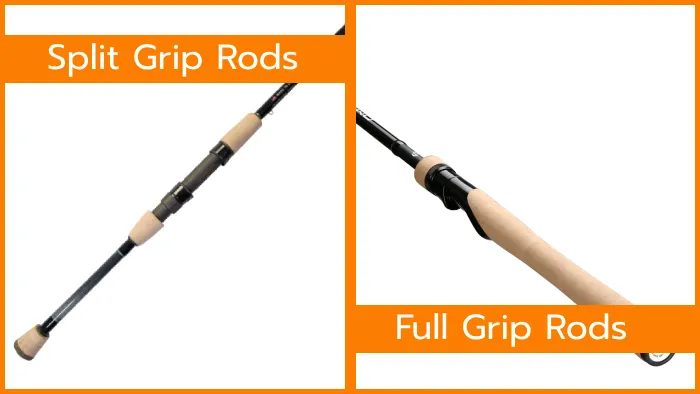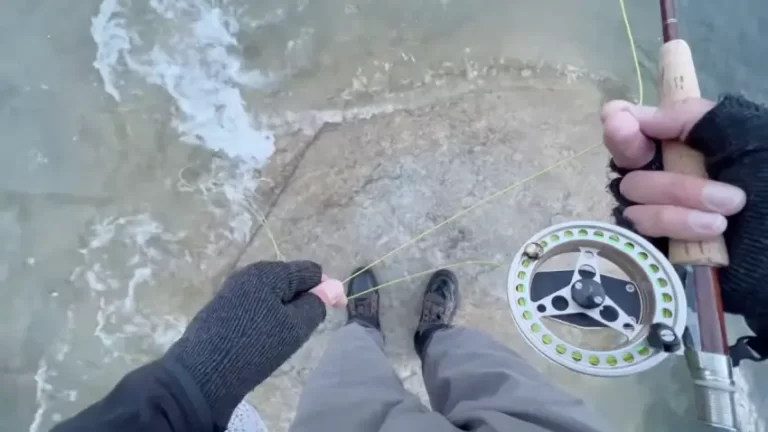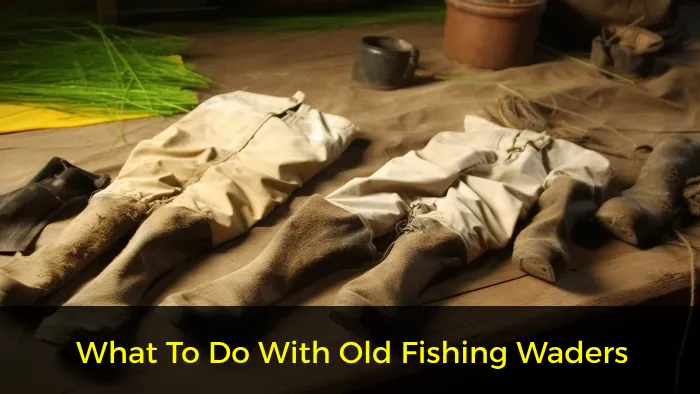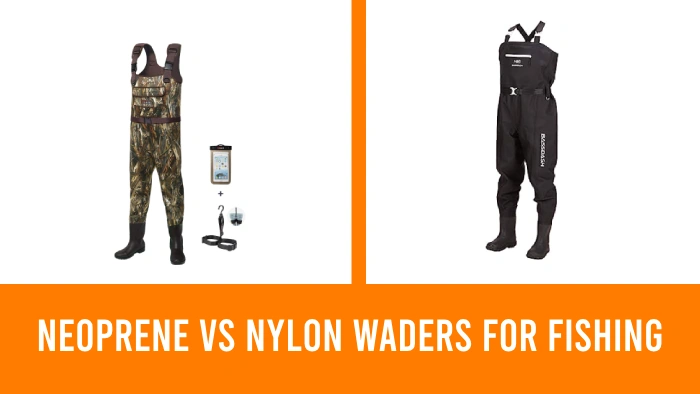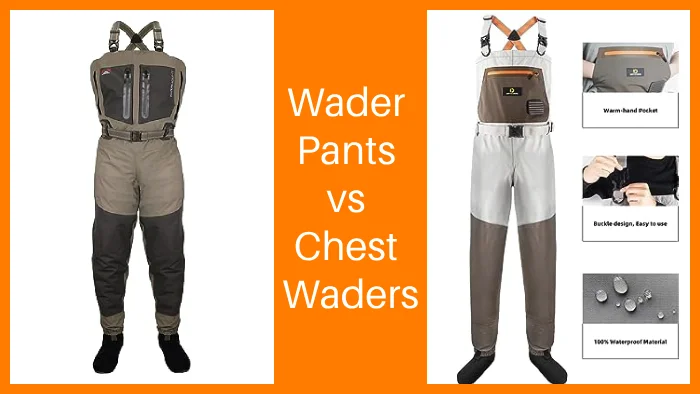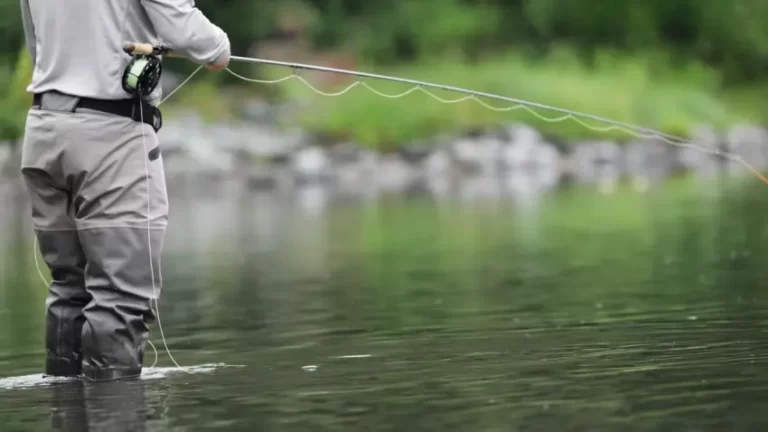Split Grip vs Full Grip Rods: 12 Differences in Fly Fishing
Are you an avid fly fisherman looking to improve your casting distance? And this is where fly fishing rod handles play a pivotal role in an angler’s experience on the water. Split grip versus full grip handles go beyond mere stylistic considerations. It influences comfort, control, and performance in various fishing scenarios.
Split grip rods provide a more ergonomic and comfortable grip, allowing for better control and reduced hand fatigue during long fishing sessions. Conversely, full grip rods offer a classic and traditional look, appealing to those who prefer a more traditional aesthetic.
Also, split grip rods tend to have a better weight distribution, ensuring a more balanced and controlled casting experience. Meanwhile, full grip rods provide better sensitivity, allowing you to feel even the slightest nibble on your line.
Here, we will explore the differences between split and full grip fly fishing rods and how handle types affect casting distance and resale value.
Differences Between Split Grip vs Full Grip Rods in Fly Fishing
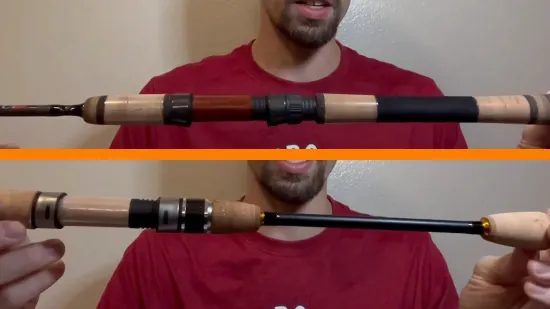
Regarding handle design, split grip and full grip fly fishing rods offer distinct advantages. Here are some of the key differences:
- Handle design
- Aesthetic appeal
- Weight distribution
- Balance and control
- Sensitivity
- Casting accuracy
- Fighting fish
- Comfort for extended use
- Noise and vibration
- Targeted species
- Versatility
- Customization options
Let’s look at each of these elements in a bit more detail.
No 01. Handle Design
Imagine yourself holding a split grip fly fishing rod in your dominant hand while the non-dominant hand rests on the blank section. The split grip design offers a unique and innovative approach to rod handles.
Dividing the grip into two parts allows for increased sensitivity and control. Having your dominant hand on the grip and your non-dominant hand on the blank improves your ability to detect subtle vibrations and movements. This design also reduces the overall weight of the rod, making it easier to handle and maneuver.
On the other hand, full grip fly fishing rods provide a more traditional and continuous handle design. While they may not offer the same sensitivity as split grips, they provide a more reliable and familiar grip that many anglers prefer.
No 02. Aesthetic Appeal
Split grip rods may be more aesthetically pleasing and more modern than full grip rods if you prioritize the visual appearance of your fishing rod.
Split grip rods have a sleek and contemporary design that appeals to many anglers who prefer a more modern look. These rods feature a shorter front and longer rear grip, creating a visually appealing asymmetry.
In contrast, full grip rods have a more traditional and classic look, with a longer, single grip that extends from the reel seat to the butt. Its shape and size make it a great option for many anglers, but it doesn’t have the same modern appeal as a split grip rod.
No 03. Weight Distribution
The weight distribution of a fly fishing rod is an important factor to consider when choosing the right rod for your needs.
With a split grip rod, the reduced weight in the handle allows for greater maneuverability and ease of fishing. This can be especially beneficial during long throwing sessions, where fatigue can become a factor. In addition to preventing muscle strain, split grip rods enable more precise and controlled aiming.
Conversely, full grip rods may be slightly heavier, but they can provide additional stability when fishing in windy conditions in South Dakota or Alaska. Also, the increased weight of a full-grip rod can help provide more power and accuracy when throwing large flies or heavy bait.
No 04. Balance and Control
When choosing a rod, you should consider the balance and control it offers. Split grip rods are designed with a balanced weight distribution, allowing for excellent control. This balance is particularly advantageous for one-arm fishing techniques, as it enables anglers to keep one hand on the rod and the other on the line.
The split grip design gives you precise control over your movements and actions.
On the other hand, full grip rods offer enhanced two-handed control, making them ideal for throwing larger lures or targeting bigger fish that require a strong grip. The full grip design ensures a secure hold and allows for powerful and accurate shooting.
No 05. Sensitivity
Split grip rods offer the perception of greater sensitivity because they expose the blank where the rod contacts your arm or ribs. This direct contact allows you to feel every little movement and vibration, providing immediate feedback.
On the other hand, full grip rods are somewhat sensitive. The main difference lies in the sensation you experience while fishing. Some anglers prefer the direct feedback split grips provide, while others find comfort in the full grips.
No 06. Casting Accuracy
Both split grip and full grip fly fishing rods can deliver comparable results regarding casting accuracy. Split grips do not inherently offer a significant advantage in this aspect. Anglers can achieve pinpoint accuracy with both handle types, depending on their casting technique and experience.
But full grips do come with an advantage. They better shield your hands from the line and ensure a smoother casting motion. This makes them preferable for novice anglers who are only getting accustomed to fly fishing.
With practice, split grip rods can also be used effectively. The key is to make sure that your hands stay steady throughout the casting motion so as not to disrupt the line.
No 07. Fighting Fish
To effectively battle fish, you’ll need to adjust your grip based on the size and strength of the fish you’re facing. Each offers unique advantages when it comes to split grip and full grip fly fishing rods.
Split grips are perfect for finesse and control, especially when dealing with smaller fish that require delicate handling. The direct contact with the blank gives you a heightened sense of control during the fight.
In contrast, full grip rods excel when facing larger and more powerful fish. The continuous handle allows for a firmer grip with both hands, which is crucial when dealing with the strength and resistance of sizable fish.
No 08. Comfort for Extended Use
When planning long days on the water, anglers may consider the comfort of split-grip fly fishing rods. These rods are designed with a handle divided into two sections, allowing for a more ergonomic grip. The split grip design makes the rod lighter, which makes it easier to hold for extended periods.
On the other hand, the full grip rods offer added padding, such as foam or cork, which enhances comfort during extended fishing sessions. While they may be slightly heavier, the added padding can help reduce strain on your hands and wrists, providing a more comfortable experience overall.
No 09. Noise and Vibration
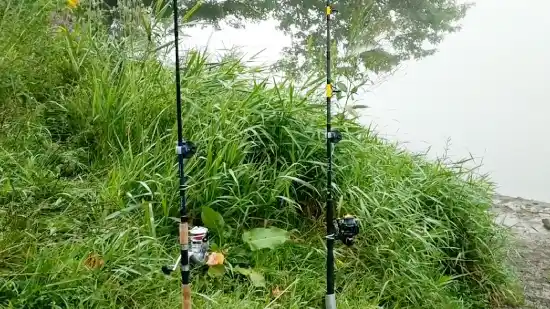
The construction of the handle can affect how much noise and vibration is transmitted to you as the angler. Regarding split grip and full grip fly fishing rods, there are some notable differences in their ability to dampen vibrations and reduce noise.
Split grip rods, which have direct contact with the blank, are known to transmit vibrations more effectively. This can provide a heightened sensory experience, allowing you to feel even the tiniest nibble.
Alternatively, with their additional padding, full-grip rods can help dampen some of the vibrations. This results in a quieter and more comfortable fishing experience, particularly when you’re casting heavy lines or flies.
No 10. Targeted Species
If you’re going after smaller, agile fish that require finesse and delicate presentations, a split grip rod is the way to go. The split grip design allows for better control and sensitivity, making it easier to make accurate casts and subtle movements.
Then again, if you’re pursuing larger, more powerful species that demand a firmer grip and more forceful control, a full-grip rod is the better option. The full grip provides a solid and secure hold, giving you the strength and leverage to handle these formidable fish.
No 11. Versatility
To maximize versatility, consider the adaptability of the handle construction on your fly fishing rod.
Split grip rods excel in active, one-arm casting techniques, making them ideal for anglers who prefer a more dynamic approach. The split design allows for better control and maneuverability, giving you the ability to make quick, accurate casts.
In contrast, full grip rods offer versatility through their adaptability to two-handed casting. This makes them suitable for a wide range of fly fishing scenarios, especially when you need to generate more power and distance.
No 12. Customization Options
When personalizing your gear, split grip rods offer more customization options than full grip rods.
With split grip rods, the exposed blank section allows for a wide range of creative options. You can add decorative wraps or custom finishes to make your rod truly unique. This level of customization allows you to showcase your personal style and preferences on the rod itself.
Conversely, full grip rods offer customization possibilities through handle materials and reel seat choices. While they may not provide as many options as split grip rods, you can still make your rod stand out by selecting high-quality materials and finishes.
Comparison Table Between Split Grip and Full Grip Fly Fishing Rods
| Aspect | Split Grip Fly Fishing Rods | Full Grip Fly Fishing Rods |
| Handle Design | Divided grip with exposed blank | Continuous handle along the length |
| Weight Distribution | Lighter due to less material | Slightly heavier but offers stability |
| Balance and Control | Balanced weight distribution, suitable for one-arm fishing | Better two-handed control, ideal for heavier rods |
| Sensitivity | May provide the perception of greater sensitivity | Traditional sensitivity with added comfort |
| Aesthetic Appeal | Modern and visually appealing | Traditional and classic appearance |
| Casting Accuracy | Comparable accuracy between both types | No significant advantage for either |
| Comfort for Extended Use | Lighter weight reduces fatigue | Padding enhances comfort during long sessions |
| Targeted Species | Suited for smaller, agile fish | Ideal for larger, more powerful species |
| Versatility | Versatile for one-arm casting | Accommodates two-handed casting techniques |
| Fighting Fish | Suitable for finesse and control | Provides a firm grip for larger, powerful fish |
| Cost and Availability | Popular but competitively priced | Widely available with reasonable pricing |
What is the impact of handle design on fly rod casting distance?
Your casting distance in fly fishing is primarily influenced by factors like rod length, line weight, casting technique, and your skill, rather than the handle design, whether it’s split grip or full grip.
The handle design does not significantly impact how far you can cast your line. Instead, the combination of the rod length, line weight, and casting technique determines the distance you can achieve.
A longer rod allows for greater leverage and a longer casting stroke, resulting in longer casts. Similarly, a heavier line can help you load the rod more effectively and generate more power in your cast.
Do handle types affect the resale value of fly fishing rods?
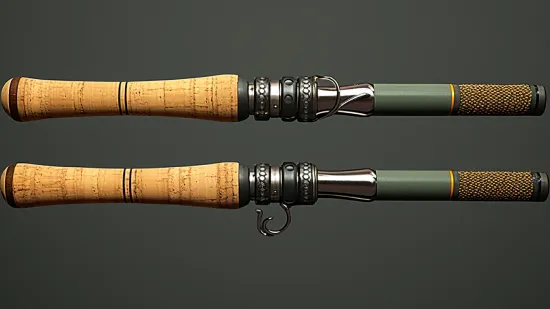
While handle type may be a consideration for some buyers, it typically doesn’t significantly impact the resale value. When determining the value of a used fly fishing rod, buyers are more concerned with factors such as the rod’s brand, model, condition, and overall performance.
These elements have a greater influence on the rod’s worth in the resale market. As a result, the handle type is often a minor factor in determining value.
Split Grip or Full Grip Fly Fishing Rods: Which One is Right for You?
Now you know the differences between split grip and full grip fly fishing rods.
As we’ve seen, split grip handles offer a modern and lightweight appeal, ideal for one-arm casting and sensitivity seekers. In contrast, full-grip handles provide stability, control, and comfort, particularly in tough fishing scenarios.
With fly fishing continuing to evolve and innovate, the split grip vs. full grip debate highlights the wide variety of options available. Ultimately, the decision hinges on individual preferences, casting techniques, and the quest for that elusive perfect day on the water.
Happy fishing.

